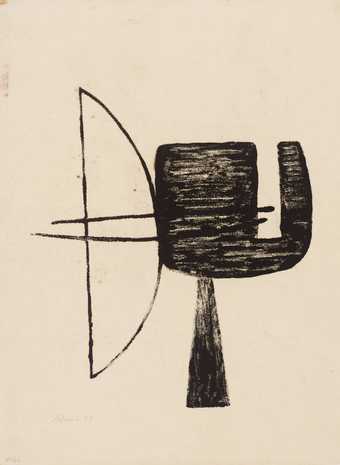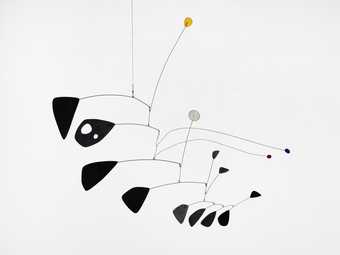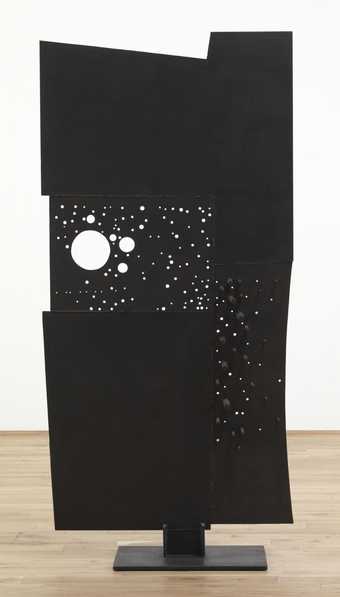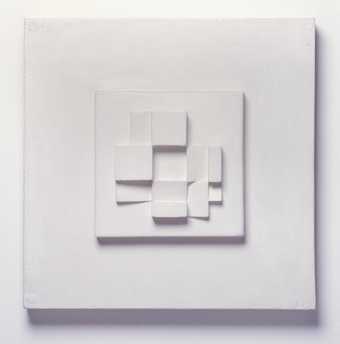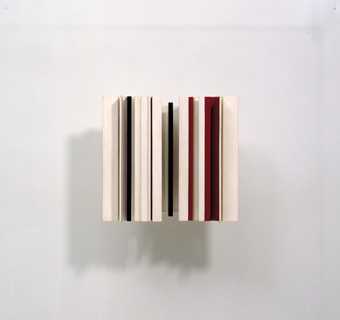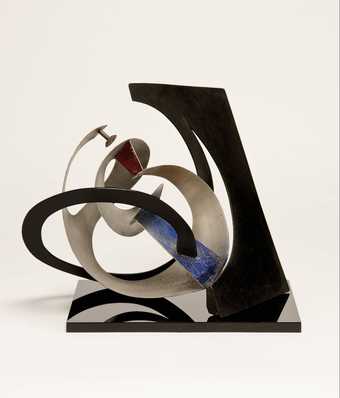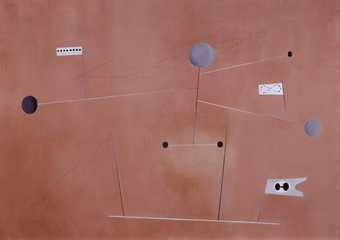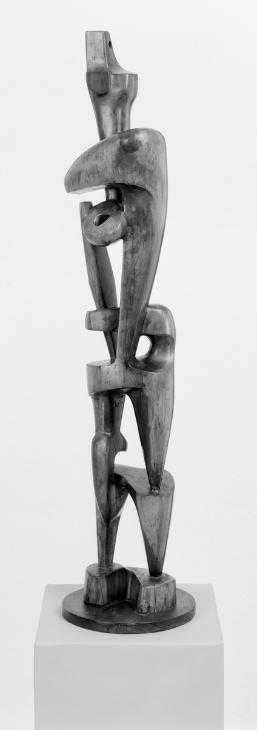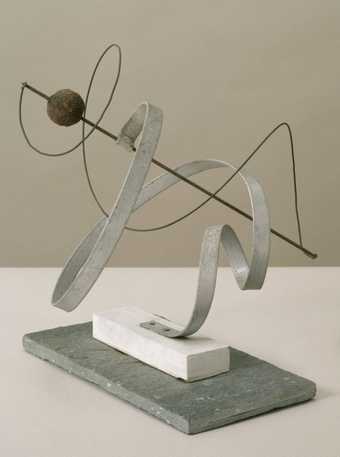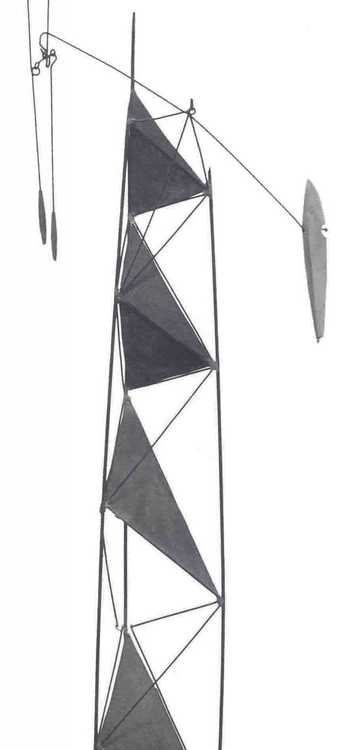
Not on display
- Artist
- Robert Adams 1917–1984
- Medium
- Steel wire and wood
- Dimensions
- Object: 940 × 420 × 410 mm
- Collection
- Tate
- Acquisition
- Purchased 1995
- Reference
- T07034
Summary
Space Construction with a Spiral was probably made in Hardingstone, near Northampton, where Adams lived, or at the Central School of Art, London, where he taught from 1949 until 1961. It was exhibited at Gimpel Fils, London, in July 1951, and reproduced in Toni del Renzio’s article ‘First Principles and Last Hopes’ published in Typographica. In that article it was positioned adjacent to a photograph of Eduardo Paolozzi’s open-frame construction Fountain, which had been commissioned for the South Bank site of the Festival of Britain.
In Nine Abstract Artists: Their Work and Theory, published in 1954, Lawrence Alloway suggested that Robert Adams’s conversion from naturalism to pure abstraction had been slow. He argued that the process had only reached completion after 1949 when the ‘physical identity of his materials asserted their autonomy and abolished the last head and the last torso’ (Alloway, p.3). In fact, clear figurative references continued in much of his work through to the early to mid 1950s. Nonetheless, 1948, a year in which Adams made several visits to Paris, was particularly important in his development as an abstract artist. His sketchbooks (Tate Archive) during that year and 1949 reveal a new awareness of the sculptures of Pablo Picasso (1881-1973), Julio Gonzalez (1876-1942), Constantin Brancusi (1876-1957), and Henri Laurens (1885-1954), as well as Barbara Hepworth (1903-1975) and Henry Moore (1898-1986). It is in these sketchbooks that Adams developed ideas for open frame sculpture like Space Construction with a Spiral.
The sculpture is a freestanding structure made from bent wire. The central motif is a spiral that rises from the base and ends at about the mid point. Soldered to it are five angular wire elements, some of which are partially painted. At either end of these elements are attached small painted wooden balls of various sizes and colours. As the viewer moves around the piece the open design described by the wire elements closes up and forms a sharp pinnacle. This process of expansion and contraction echoes the development of a spiral.
The spiral was a recurring motif in the work of a group of artists, which included Victor Pasmore (1908-1998), Anthony Hill (b.1930), Kenneth Martin (1905-1984), Adrian Heath (1920-1992) and Mary Martin (1907-1969), who were committed to re-establishing non-figurative art in Britain in the years following the Second World War (1939-45). In ‘Abstract Art’, Kenneth Martin’s contribution to the group’s first publication Broadsheet No.1: Devoted to Abstract Art I, published in June 1951, Martin clarified the group’s position by stating that their strain of abstraction was not abstracted from nature but rather copied ‘nature in the laws of its activities’ (quoted in Grieve 1990, p.774). To a certain extent, this reflected Naum Gabo’s (1890-1977) thoughts on the role and form of visual art in a scientific age. In his Trowbridge lecture at Yale University in 1948, Gabo, who had himself received a formal science education, argued for an abstract art that was not merely formal, but that was an adjunct to a scientific understanding of reality. In this context, D’Arcy Wentworth Thompson’s On Growth and Form, first published in 1917 and re-published in 1942, was a seminal text for artists attempting to create a scientific iconography. Thompson’s thesis on the development of organic forms contained numerous illustrations of cellular growth patterns, among which were several showing naturally occurring spirals. Thompson demonstrated that these spirals could be understood as mathematical ratios, and thereby married natural processes with mathematics. Gabo, who is reported to have read On Growth and Form prior to its re-publication, made Spiral Theme (Tate T00190) around 1941. The spiral later became a recurring motif in the work of the Constructionist group.
The spiral also allowed the artists to incorporate space into their work as an architectonic element. According to Alloway it had been a particularly important device in Adams’s earlier work, in which ‘angular or curved blocks are arranged in storeys that read as a spiral movement: solids lightened by being perforated and separated from each other by pegs. Thus the surrounding space is brought into active relation with the volumes, without loosening the central form’ (Alloway, p15). A good example of this is Figure, 1949 (Tate T03866).
Further reading:
Toni del Renzio, ‘First Principles and Last Hopes’, Typographica, no.4, 1951, pp.14-20, reproduced p.15
Lawrence Alloway, Nine Abstract Artists: Their Work and Theory, London 1954
Alastair Grieve, Robert Adams 1917-1984: A Sculptor’s Record, London 1992
Alastair Grieve, ‘Towards an Art of Environment: Exhibitions and Publications by a Group of Avant-garde Abstract Artists in London 1951-55’, Burlington Magazine, vol.132, November 1990, pp.773-81
Toby Treves
November 2000
Does this text contain inaccurate information or language that you feel we should improve or change? We would like to hear from you.
Explore
- abstraction(8,615)
-
- non-representational(6,161)
-
- geometric(3,072)
- formal qualities(12,454)
You might like
-
Robert Adams [title not known]
1957 -
Alexander Calder Antennae with Red and Blue Dots
c.1953 -
Robert Adams Large Screen Form No. 2
1962 -
Mary Martin Spiral Movement
1951 -
Victor Pasmore Relief Construction in White, Black and Maroon
1962–3 -
Peter Lanyon Construction
1947 -
Paule Vézelay Construction. Grey Lines on Pink Ground
1938 -
Robert Adams Figure
1949 -
John Wells Construction
1940–1 -
Lynn Chadwick Stabile with Mobile Elements
1950

